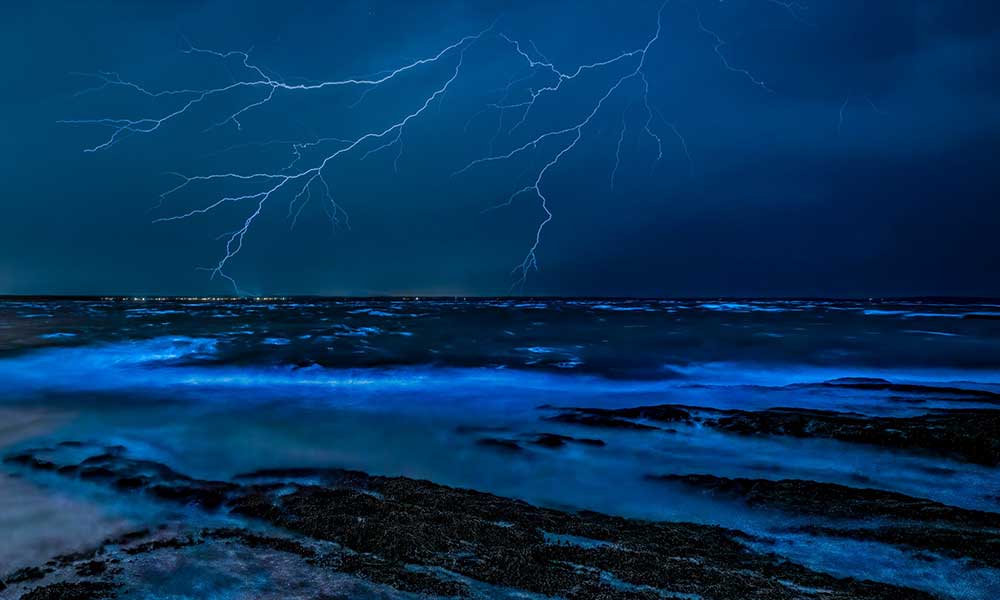Living organisms present in the water create bioluminescence, which is the production of light.
Bioluminescence can last days or even weeks in the ocean. Even scientists are often unable to predict how long the blue tides will last.
Bioluminescence is a chemical reaction when a species has luciferin. Luciferin is a molecule that produces light when it has contact with oxygen.
It commonly occurs with squid, some types of fish, shrimp, and phytoplankton. Approximately 76 percent of animals in the ocean are bioluminescent. A lot of organisms in the ocean also create luciferase, which is a faster reaction.
This commonly occurs when there’s an algae bloom of plankton in the water. It starts to glow when there’s a wave, and it becomes disturbed. It’s also known as a natural defense mechanism.
The blue light is only visible at night and can travel the farthest in water.
How Long Does Bioluminescence Last?
It can be challenging and unpredictable to determine how long bioluminescence lasts.
This makes it difficult to know how long it will be present in the water before it disappears.
In 2021, the bloom lasted for about six weeks off the coast of California, which is the longest occurrence recorded in history. There are other times that it’s only present for a few days.
The neon illumination was incredibly strong and easy to see from a distance.
A top indicator that bioluminescence will be present at night is if you see a red hue present in the water during the day.
When waves and currents are present, it causes it to be pushed in other directions in only a few hours.
The frequency of bioluminescence is currently increasing in different parts of the world since the 1960s.
There is not enough research conducted to determine why it’s becoming more common.
Should You Go In The Water Then Bioluminescence Occurs?
Bioluminescence is not harmful to humans, making it safe to swim near the natural phenomenon.
It doesn’t affect the cleanliness of the water.
Many people prefer to dive in and surround themselves with the illuminated organisms for a magical experience at night.
Some locations discourage swimming in the water because it can affect the wildlife.
It’s important to use caution and proper safety when swimming at night, where lifeguards are typically not present.
Many tours are also available at different locations where visitors can get a first-hand look at bioluminescence from inside a boat, which is a safer method for viewing the phenomenon.
Some people may be sensitive to the air that is present during red tides while surfing or swimming.
This makes scientists assume they’re producing other types of compounds that can affect some people’s health.
There is still no public health warning associated with the red or blue tides.
It’s also important to keep in mind that many of these locations have cold temperatures, which can make it challenging to spend more than a few minutes in the water.
Some red tides are even known to cause sinus issues and respiratory problems in some individuals.
Itchy skin is another common symptom some people experience after getting out of the water.
What Causes Bioluminescence?
Bioluminescence is caused by different types of animals that can create their own light due to energy.
The chemical energy transitions into light compared to heat like humans.
These organisms have the ability to glow in the dark as the light is produced due to a chemical reaction.
It requires either luciferin and luciferase or photoprotein to occur.
Most types of bioluminescent organisms are present in the ocean, which includes jellies, bacteria, and fish.
They only live in saltwater and are not present in any freshwater bodies of water.
Other types of organisms don’t produce bioluminescence but absorb it from other types of organisms present in the water.
When Does Bioluminescence Happen?
History shows that bioluminescence commonly occurs during the warmer months of the year in the summer season.
It typically occurs from the months of May to October.
It’s also reported to be visible for five days after a full moon occurs. There are even times it can still occur during the fall when the temperatures are high.
The best time to look for bioluminescence is when new moons are present, and there isn’t any moonlight reflecting off the water to ensure it’s more visible.
This event occurs every few years, mainly near the Southern Californian coast.
It continues to appear more vibrant in recent years, attracting a lot more viewers.
The historic rains that have caused more algae to bloom are likely contributing to this phenomenon.
Where To See Bioluminescence In California?
Bioluminescence is easy to find in California and has recently been present off the coast near Dana Point, Laguna Beach, and Newport Beach in 2021.
Many scientists also believe it will be visible in San Diego, according to the Southern California Coastal Ocean Observing System.
Mission Bay in San Diego, California is a popular spot where bioluminescence has been present in the past and will likely be a location to visit to view it again.
It is also present at different beaches during the spring season in California, allowing it to be easier to find throughout the year.
Wait until after the sun sets to visit the beach and get a chance to see the blue glow in the water when it’s typically most visible.







